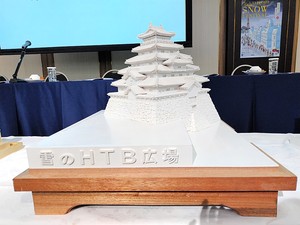By JUNICHI KAMIYAMA/ Staff Writer
December 2, 2021 at 18:05 JST
Nissan Motor Co.'s new vehicle is out of this world, but don't look for it in any showroom.
The major automaker rolled out an unmanned rover prototype to operate on the moon on Dec. 2.
Nissan utilized its electric car’s all-wheel-control technology to allow the lunar buggy to run on the moon surface under harsh conditions.
“We would like to make the vehicle operable on the moon even if the lunar soil blocks its wheels,” said Toshiyuki Nakajima, head of advanced vehicle engineering for Nissan.
The Japan Aerospace Exploration Agency (JAXA) is expected to adopt the vehicle as an exploration car.
The moon has only one-sixth of the Earth’s gravity and its surface is covered by fine powdery soil, which is difficult for any vehicle to traverse stably.
Nissan and JAXA jointly developed the prototype of the unmanned moon rover.
The vehicle is powered by four motors and has lithium-ion batteries. The all-wheel technology that powers both the front and rear wheels at the same time allows the vehicle to run on the powdery soil.
This technology will be used for Nissan’s new crossover Ariya electric car, which will be marketed next summer.
The operating tests were done repeatedly on a Nissan test course and at a JAXA experimental facility.
As for other future lunar vehicles, Toyota Motor Corp. and JAXA are currently developing the manned exploration Luna Cruiser and aiming to launch it in 2029.




















A peek through the music industry’s curtain at the producers who harnessed social media to help their idols go global.
A series based on diplomatic documents declassified by Japan’s Foreign Ministry
Here is a collection of first-hand accounts by “hibakusha” atomic bomb survivors.
Cooking experts, chefs and others involved in the field of food introduce their special recipes intertwined with their paths in life.
A series about Japanese-Americans and their memories of World War II